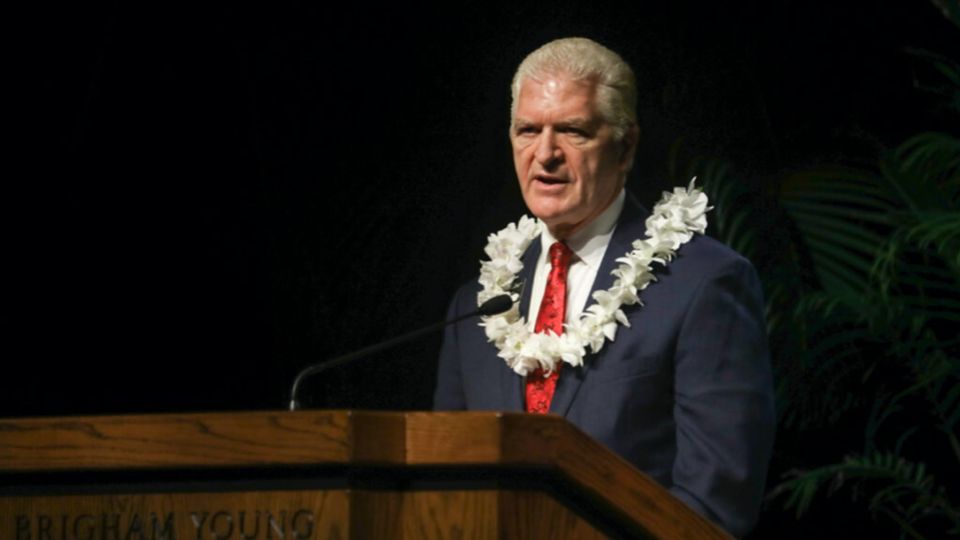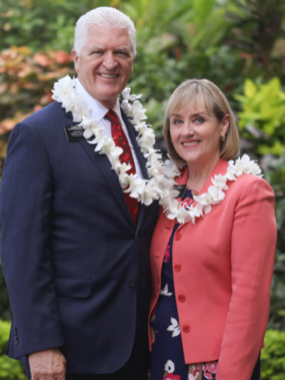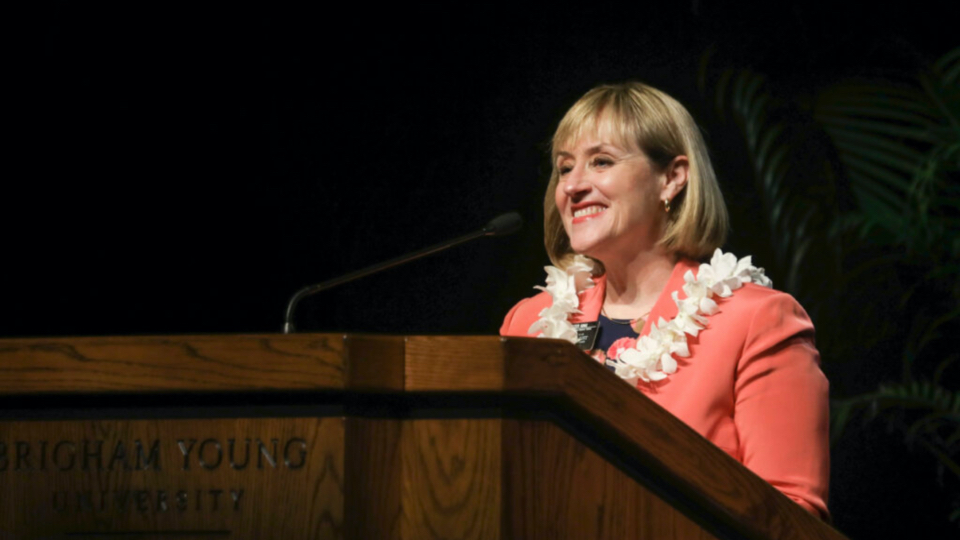
Cycling Lesson 1
Elder Steven D. King, director of the Laie Hawaii Temple Visitors’ Center, addresses students in a BYU–Hawaii devotional on November 3, 2020. Photo by Monique Saenz, courtesy of Church News. All rights reserved.This story appears here courtesy of TheChurchNews.com. It is not for use by other media.
By Megan McKellar, Church News
Elder Steven D. King, director of the Laie Hawaii Temple Visitors’ Center, used the Aesop’s fable “The Tortoise and the Hare” to teach how a consistent “cadence” over time will produce dramatic results in a BYU–Hawaii devotional on November 3, 2020.
“The turtle kept a consistent cadence,” Elder King said. “Cadence is the amount of time between repetitive actions, like the turtle’s steps.”
The Savior’s consistency and cadence about His doctrine can be found in many instances in the scriptures, Elder King said.
In Doctrine and Covenants 17:6, the Savior said of the Book of Mormon translation by Joseph Smith: “And he has translated the book, even that part which I have commanded him, and as your Lord and your God liveth it is true.”
He continued, “To illustrate the Lord’s cadence, He follows only one section and few verses later by bearing the same consistent testimony, ‘Behold, I have manifested unto you, by my Spirit in many instances, that things which you have written are true; wherefore you know that they are true,’” (Doctrine and Covenants 18:2).
“Consistently a cadence of testifying of truth,” Elder King noted.
A serious cyclist, Elder King then explained the principle of cadence as it related to cycling.
“In cycling, cadence is the rate at which a cyclist is pedaling, measured in rotations per minute,” he said.
Hours in the saddle and years accruing miles has taught him some valuable lessons as he has applied them to the doctrines taught in the gospel of Jesus Christ.
The first lesson from cycling as it applies to the gospel of Jesus Christ is to keep your balance. “Keep yourself grounded and balanced on (the covenant) path, always moving forward to maintain balance,” Elder King said.

Cycling Lesson 3
Elder Steven D. King, director of the Laie Hawaii Temple Visitors’ Center, addresses students in a BYU–Hawaii devotional on November 3, 2020. Photo by Monique Saenz, courtesy of Church News. All rights reserved.Obeying the rules of the road is the second principle of cycling as it relates to the gospel of Jesus Christ.
Those who build roads establish road signs to provide help along the path they designed. “In our vernacular, we’ll call that the covenant path,” Elder King said. “Obedience to the rules of the road will bring us safety and security and will help us ‘stay the course.’”
The next lesson from cycling that Elder King taught was to keep your eyes on the road, looking ahead to avoid danger.
He emphasized the need to follow the prophet and to “stay on the same track.” “Don’t think you will be safe if you ride on a parallel track,” Elder King cautioned.
Another cycling principle that can be applied to the gospel of Jesus Christ is to ride in groups and take turns leading.
Elder King explained the concept of drafting, when cyclists riding in a group each take a turn in the lead position. Leaders expend more energy but help the riders behind them, and leaders take a short rest when the rest of the group members rotate and take turns as the leader.
“Most of Church leadership is organized this way,” Elder King said. “When we rotate out, we follow and draft behind those who push forward to lead us.”
A related principle to drafting is signaling to others about road hazards.
“When encountering road hazards, audible signals are given as well as hand gestures to avoid the imminent danger,” Elder King said. “We trust the lead. When it is our turn to lead, the others trust us. In the Church, this is known as a sustaining vote or doing things by common consent.”
Finally, the last lesson he taught from cycling is to use all your gears to keep a consistent cadence.
“Your cadence and speed may slow as you climb up a hill or you may accelerate to a quicker cadence and speed on the flat but being a rider with a consistent cadence will set you apart and make you a stronger rider,” Elder King said. “Others will trust you because you are consistent.”
Practicing a constant cadence is helpful in several aspects of the gospel of Jesus Christ, Elder King said, such consistently immersing ourselves daily in the scriptures, meeting with the Saints regularly, paying an honest tithe and other offerings, living temple worthy and attending the temple regularly, watching for opportunities to minister and following the promptings of the Spirit immediately.
The Savior, who is the “Master Cyclist,” will “lead the way, breaking the wind so we may all cross the finish line together.”
“The closer we ride to Him, the more efficient we become. In all of this, He is my Savior,” Elder King said.
In their calls to serve, both over the Atlanta Georgia North mission and in their current calling in the Laie Hawaii Temple Visitors’ Center, Elder and Sister King have had to change life plans and sacrifice in order to answer the call to serve.
“We knew it would be well worth it,” Sister King said. “Turns out, there were reasons for both calls, and God knew it!”
A key to trusting in the Lord is choosing to be patient, she taught, quoting Elder Neal A. Maxwell of the Quorum of the Twelve Apostles, who said that we need to be willing “to watch the unfolding purposes of God with a sense of wonder and awe, rather than pacing up and down within the cell of our circumstance” (BYU Speeches, “Patience,” November 27, 1979).
The Lord administers His timing through continuing revelation. So much has miraculously been done because of revelation, Sister King said, referencing the number of temples doubling under President Gordon B. Hinckley, as well as the numerous adjustments that have come about in the Church under President Russell M. Nelson.

Cycling-Lesson-2.jpg
Elder Steven D. King and Sister Michelle King at BYU–Hawaii on November 3, 2020. Photo by Monique Saenz, courtesy of Church News. All rights reserved.“And years ago, President Nelson wanted mobile devices in the missionaries’ hands, until, in January of this year, that finally happened for sisters and elders all over the world. Just in time, too — that was the month before COVID-19 hit,” Sister King noted. “And the many ways missionaries have been able to use technology ever since and spread the gospel has been simply amazing!”
Sometimes prayers are not answered the way we want, she said. “Sometimes the Lord even says no to a worthy request or something that would bring us happiness.”
Sister King recounted how some of the sister missionaries serving in the visitor’s center, due to the coronavirus, had to resume missions in places they weren’t assigned or needed to return home early. In addition, over 130 senior missionaries from the Laie Hawaii Temple Visitors’ Center, the Polynesian Cultural Center and BYU–Hawaii had to return home to safeguard their health.
Then, at the end of July, the number of young sister missionaries began to grow and nearly quadrupled as sisters arrived who had originally been assigned there, as well as reassigned sisters.
“We need them to help the members and do all the missionary work connected with our Visitors’ Center Virtual Tours and in our Teaching Center, and more,” Sister King said. “So, trust in the Lord and His timing, even when it’s not what we planned.”
Sister King’s mother, a “bright, multi-talented woman,” has suffered from dementia/Alzheimer’s for over 10 years.
“I often wonder why her? And, sometimes, I think why us? Or why me?” Sister King said. “But maybe, instead, we should ask the question Elder Maxwell asked when he was diagnosed with leukemia: ‘Why not me?’ And ask … What am I to do? What am I to learn? What am I to change? Whom am I to help?”
When we trust in the Lord, she taught, He can direct our paths for good and help us accomplish that purpose through the Holy Ghost.
“Our path has taken us here to Laie, Hawaii. We know we’re supposed to be here—and, maybe when our time here is complete, we’ll better understand all the reasons why,” Sister King said. “But we know by now that we trust our Heavenly Father.”
Copyright 2020 Deseret News Publishing Company